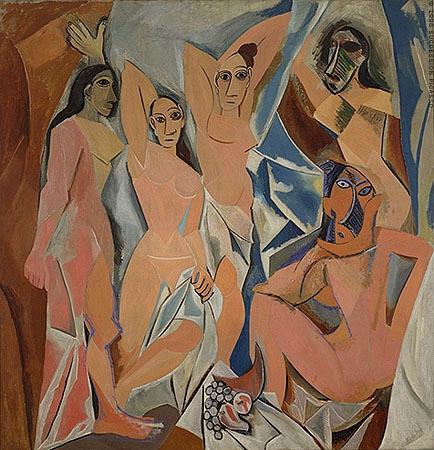Les Demoiselles d'Avigon - Pablo Picasso Weinende_Frau - Pablo Picasso

Les Demoiselles d'Avigon - Pablo Picasso
(1881-1973), Spanish
painter and sculptor, generally considered the
greatest artist of the 20th century. He was
unique as an inventor of forms, as an innovator
of styles and techniques, as a master of various
media, and as one of the most prolific artists
in history. He created more than 20,000 works
and paintings.
Inspired by the volumetric treatment of form by
the French postimpressionist artist Paul
Cezanne, Picasso and the French artist Georges
Braque painted landscapes in 1908 in a style
later described by a critic as being made of
little cubes, thus leading to the term cubism.
Some of their paintings are so similar that it
is difficult to tell them apart. Working
together between 1908 and 1911, they were
concerned with breaking down and analyzing form,
and together they developed the first phase of
cubism, known as analytic cubism. Monochromatic
color schemes were favored in their depictions
of radically fragmented motifs, whose several
sides were shown simultaneously. Picasso's
favorite subjects were musical instruments,
still-life objects, and his friends; one famous
portrait is Daniel Henry Kahnweiler (1910, Art
Institute of Chicago).
In 1912, pasting paper and
a piece of oilcloth to the canvas and combining
these with painted areas, Picasso created his
first collage, Still Life with Chair Caning (Mus嶪
Picasso, Paris). This technique marked a
transition to synthetic cubism. This second
phase of cubism is more decorative, and color
plays a major role, although shapes remain
fragmented and flat. Picasso was to practice
synthetic cubism throughout his career, but by
no means exclusively. Two works of 1915
demonstrate his simultaneous work in different
styles: Harlequin (Museum of Modern Art) is a
synthetic cubist painting, whereas a drawing of
his dealer, Vollard, now in the Metropolitan
Museum, is executed in his Ingresque style, so
called because of its draftsmanship, emulating
that of the 19th-century French neoclassical
artist Jean August Dominique Ingres.
|








